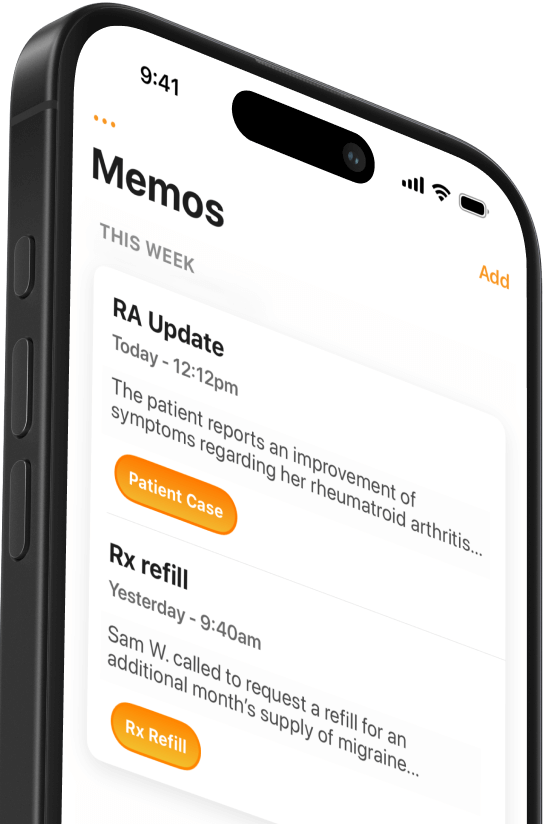Everything You Need to Know About Medical Speech Recognition Software
Explore the latest advances in AI-powered medical dictation, including how Conveyor AI combines speech recognition and ambient scribing in one secure platform.


Popular articles
Everything You Need to Know About Medical Speech Recognition Software
Medical speech recognition software has transformed how clinicians document care. Once limited to basic speech to-text dictation, today’s tool’s use advanced artificial intelligence (AI) to understand medical context, terminology, and even the structure of complete clinical notes.
If you’re exploring options, this guide explains what medical speech recognition is, how it works, the benefits for clinicians, and what features to look for when choosing a solution.
What Is Speech Recognition Software?
Speech recognition software, also known as automatic speech recognition (ASR) or speech-to-text, is technology that translates spoken words into written text.
In healthcare, speech recognition allows clinicians to dictate directly into their electronic health record (EHR) or computer instead of typing or using transcription services. Instead of sending recordings to an off-site transcriptionist, providers can speak naturally and see their words appear instantly on screen.
Medical dictation software is designed for clinical workflows, incorporating medical vocabularies, formatting, and HIPAA-compliant data protection.
How Does Speech Recognition Work?
Most speech recognition systems follow a few key steps (see NIST’s Speech Analytics program for background on how automatic speech recognition is measured and evaluated):
- Capture: The software converts sound waves from your voice into digital data.
- Processing: That data is broken down into small sound units and matched to phonemes — the basic building blocks of language.
- Interpretation: The software analyzes phoneme sequences, compares them with its vocabulary database, and determines what was said.
- Output: Finally, it produces text or executes a command.
Medical speech recognition adds an important layer: a specialized medical terminology database. This ensures that words like lisinopril or cellulitis are recognized accurately within a clinical context.
Benefits of medical speech recognition software
Many doctors use medical speech recognition software to save time and reduce the burden of typing. Typing is slow — most clinicians average around 30 words per minute (WPM) — while speech recognition software can transcribe more than 150 WPM, the average conversation rate for English speakers in the U.S. In short, dictation is faster than typing, and for busy clinicians, that time savings adds up quickly.
But speed isn’t the only reason physicians are turning to speech-to-text software for clinical notes. Medical speech recognition tools also improve efficiency, accuracy, and even patient engagement.
Efficiency
Dictation and AI scribing drastically reduce after-hours charting, as shown in a JAMA Network Open study on virtual scribes.
Accuracy
Modern medical dictation software is trained on large databases of medical language, enabling it to recognize drug names, complex phrasing, and abbreviations with impressive precision. When clinicians speak naturally, the software captures subtle context that might otherwise be lost in typed notes.
Clinician Satisfaction
Studies show that physicians who use speech recognition software report higher satisfaction with their documentation process. Fewer late nights spent charting and a smoother workflow contribute to reduced burnout and better work-life balance.
Patient Engagement
Speaking notes aloud during the encounter can also serve as an effective patient engagement strategy. When patients hear their provider summarize key details in real time, it builds transparency, encourages collaboration, and helps patients feel more involved in their care.
What to Look For in Medical Speech Recognition Software
If you’ve started exploring medical speech-to-text software, you’ve probably noticed there are a lot of options. From traditional dictation apps to advanced AI scribing tools, it can be hard to know which solution is right for your workflow.
So, what features should you prioritize in medical speech recognition software? Here are five key things to look for.
1. Easy Setup
First, you want software that’s easy and intuitive to start using. Any change to your documentation workflow will take some initial adjustment, but a well-designed interface should feel familiar from the start.
Look for a medical dictation app that keeps things simple. It should be powerful enough to improve efficiency but not overloaded with unnecessary features. If the company recommends attending long training sessions before you can begin, that might be a red flag.
2. Designed for Doctors
Using free or generic speech recognition software that isn’t built for medicine might be tempting, but it’s rarely a good idea. Medical dictation software offers two essential advantages: security and specialized functionality.
Security comes first. Any application that handles protected health information (PHI) must be HIPAA compliant, so this should be your baseline requirement before bringing new software into your workflow.
Just as important, look for speech-to-text tools designed by doctors for doctors. Medical-specific software recognizes complex terminology, understands clinical phrasing, and is more likely to integrate seamlessly with your EHR and other systems you use every day.
Ideally, your medical speech recognition software should work anywhere you type — in your EHR, Word documents, or web-based platforms — without disrupting your existing workflow.
3. Works on All of Your Computers
Many clinicians use a PC at work and a Mac at home, and some move between hospital workstations throughout the week. Unfortunately, not all dictation software is cross-compatible.
If you finish clinical notes from home, as most family physicians do, make sure your software works on both Mac and PC. Look for a cloud-based solution that saves your voice profile, templates, and preferences across devices, so your workflow travels with you wherever you practice.
4. Mobile
Today’s clinicians need flexibility. The best medical speech-to-text software works on smartphones and tablets as well as computers.
A mobile app lets you dictate anywhere — whether you’re between patients, reviewing notes on rounds, or catching up at home. Features like dictation memos let you record on your phone and save your note to the chart later.
Many cloud-based solutions also let you use your phone as a wireless microphone for instant dictation on any computer. In other words, your most powerful speech-recognition tool might already be in your pocket.
5. Great Support
Even the best technology raises questions. Maybe you’re wondering how to move your software to a new computer or which voice commands can save you the most time.
Choose a provider that offers excellent customer support, clear onboarding, and quick access to resources. Before committing, read reviews, ask colleagues about their experiences, and check whether the company provides live support or training when you need it.
The Future of Medical Dictation
Speech recognition has evolved from a convenience to a clinical necessity. As AI advances, clinicians can expect even smarter, faster, and more human-like tools that understand clinical nuances and adapt to individual workflows.
For more on where the field is heading, check out:
Whether you're looking for a straightforward dictation tool or an ambient AI-scribe solution, investing in the right technology can help you document less and focus more on patient care.
FAQs About Medical Speech Recognition
As more clinicians adopt dictation, a few common questions come up about how speech recognition works in daily practice. Below are answers to some of the most frequent ones.
How accurate is medical speech recognition?
Top medical dictation software can achieve 95–99% accuracy, especially when trained on medical language and user speech patterns.
Can speech recognition software replace human scribes?
Ambient AI tools are increasingly capable, but most clinicians still review and finalize notes — maintaining oversight and accuracy. For example, tools like Conveyor AI can capture the entire clinical conversation and produce a complete note in under a minute.
Is medical dictation secure?
Always choose HIPAA-compliant software that encrypts all patient data, whether stored locally or in the cloud.
What’s the difference between speech recognition and ambient AI scribing?
Speech recognition converts spoken words directly into text in real time. Ambient AI scribing goes further, listening passively during patient encounters and generating structured notes automatically, reducing the need for manual dictation.
Can medical speech recognition help reduce burnout?
Yes! Clinicians often report higher satisfaction and less after-hours charting when using speech-to-text or AI scribing tools. Reducing documentation burden can free up more time for patients and personal well-being.
Related Articles


We Get Doctors Home on Time.
Contact us
We proudly offer enterprise-ready solutions for large clinical practices and hospitals.
Whether you’re looking for a universal dictation platform or want to improve the documentation efficiency of your workforce, we’re here to help.





